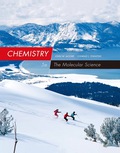
(a)
Interpretation:
The equilibrium constant expressions in terms of the unknown variable x for each given reactions has to be written by using the reaction table (ICE table) approach.
Concept Introduction:
Equilibrium constant
Equilibrium constant
Consider the reaction where A reacts to give B.
On rearranging,
Where,
(a)
Explanation of Solution
The equilibrium constant expressions in terms of the unknown variable x for 1 reaction is,
The equilibrium constant expressions for above equation is,
ICE table for the above equation is,
The equilibrium constant expressions in terms of the unknown variable x for 1 reaction is,
The equilibrium constant expressions in terms of the unknown variable x for 2 reaction is,
The equilibrium constant expressions for above equation is,
ICE table for the above equation is,
The equilibrium constant expressions in terms of the unknown variable x for given reaction is,
The equilibrium constant expressions in terms of the unknown variable x for 3 reaction is,
The equilibrium constant expressions for above equation is,
ICE table for the above equation is,
The equilibrium constant expressions in terms of the unknown variable x for given reaction is,
(b)
Interpretation:
The equilibrium constant expressions in terms of the unknown variable x for each given reactions has to be written, which of these expressions yield quadratic equations has to be given.
Concept Introduction:
Refer part (a).
(b)
Explanation of Solution
The given reactions and it’s the equilibrium constant expressions in terms of the unknown variable x are,
From the equilibrium constant expression, it yields quadratic equation.
From the equilibrium constant expression, it yields quadratic equation.
From the equilibrium constant expression, it yields quadratic equation.
(c)
Interpretation:
The equilibrium constant expression in terms of the unknown variable x for given reaction has to be written and solving of x has to be explained.
Concept Introduction:
Refer to part (a).
(c)
Explanation of Solution
The equilibrium constant expressions in terms of the unknown variable x for 3 reaction is,
The equilibrium constant expressions for above equation is,
ICE table for the above equation is,
The equilibrium constant expression in terms of the unknown variable x for given reaction is,
The above expression is not a quadratic equation so it is solved as shown below,
Let,
The valve of x is calculated as,
The calculated value is,
Want to see more full solutions like this?
Chapter 12 Solutions
EBK CHEMISTRY: THE MOLECULAR SCIENCE
- Write an equation for an equilibrium system that would lead to the following expressions (ac) for K. (a) K=(Pco)2 (PH2)5(PC2H6)(PH2O)2 (b) K=(PNH3)4 (PO2)5(PNO)4 (PH2O)6 (c) K=[ ClO3 ]2 [ Mn2+ ]2(Pcl2)[ MNO4 ]2 [ H+ ]4 ; liquid water is a productarrow_forwardBased on the diagrams, chemical reaction, and reaction conditions depicted in Problem 9-81, for which of the diagrams is the numerical value of the equilibrium constant the smallest?arrow_forwardBased on the diagrams, chemical reaction, and reaction conditions depicted in Problem 9-83, which of the diagrams represents the equilibrium mixture if the numerical value of the equilibrium constant is 9.0?arrow_forward
- What is the law of mass action? Is it true that the value of K depends on the amounts of reactants and products mixed together initially? Explain. Is it true that reactions with large equilibrium constant values are very fast? Explain. There is only one value of the equilibrium constant for a particular system at a particular temperature, but there is an infinite number of equilibrium positions. Explain.arrow_forwardWrite the equilibrium constant expression for each of the following reactions in terms of concentrations. (a) CO2(g) + C(s) 2 CO(g) (b) [Cu(NH3)4)2+(aq) Cu2+(aq) + 4 NH3(aq) (c) CH3CO2H(aq) + H2O() CH3CO2(aq) + H3O+(aq)arrow_forwardConsider the system 4NH3(g)+3O2(g)2N2(g)+6H2O(l)H=1530.4kJ (a) How will the concentration of ammonia at equilibrium be affected by (1) removing O2(g)? (2) adding N2(g)? (3) adding water? (4) expanding the container? (5) increasing the temperature? (b) Which of the above factors will increase the value of K? Which will decrease it?arrow_forward
- The value of the equilibrium constant, K, is dependent on which of the following? (There may be more than one answer.) a. the initial concentrations of the reactants b. the initial concentrations of the products c. the temperature of the system d. the nature of the reactants and products Explain.arrow_forwardWrite equilibrium constant expressions for the following generalized reactions. a. 2X(g)+3Y(g)2Z(g) b. 2X(g)+3Y(s)2Z(g) c. 2X(s)+3Y(s)2Z(g) d. 2X(g)+3Y(g)2Z(s)arrow_forwardFor the generalized chemical reaction A(g)+B(g)C(g)+D(g) determine whether the concentration of D in an equilibrium mixture will (1) increase, (2) decrease, or (3) not change when each of the following changes is effected. a. concentration of A is increased b. concentration of B is decreased c. concentration of C is increased d. concentration of C is decreasedarrow_forward
 Chemistry: The Molecular ScienceChemistryISBN:9781285199047Author:John W. Moore, Conrad L. StanitskiPublisher:Cengage Learning
Chemistry: The Molecular ScienceChemistryISBN:9781285199047Author:John W. Moore, Conrad L. StanitskiPublisher:Cengage Learning Introductory Chemistry: A FoundationChemistryISBN:9781337399425Author:Steven S. Zumdahl, Donald J. DeCostePublisher:Cengage Learning
Introductory Chemistry: A FoundationChemistryISBN:9781337399425Author:Steven S. Zumdahl, Donald J. DeCostePublisher:Cengage Learning Chemistry: An Atoms First ApproachChemistryISBN:9781305079243Author:Steven S. Zumdahl, Susan A. ZumdahlPublisher:Cengage Learning
Chemistry: An Atoms First ApproachChemistryISBN:9781305079243Author:Steven S. Zumdahl, Susan A. ZumdahlPublisher:Cengage Learning
 ChemistryChemistryISBN:9781305957404Author:Steven S. Zumdahl, Susan A. Zumdahl, Donald J. DeCostePublisher:Cengage Learning
ChemistryChemistryISBN:9781305957404Author:Steven S. Zumdahl, Susan A. Zumdahl, Donald J. DeCostePublisher:Cengage Learning Chemistry for Engineering StudentsChemistryISBN:9781337398909Author:Lawrence S. Brown, Tom HolmePublisher:Cengage Learning
Chemistry for Engineering StudentsChemistryISBN:9781337398909Author:Lawrence S. Brown, Tom HolmePublisher:Cengage Learning





